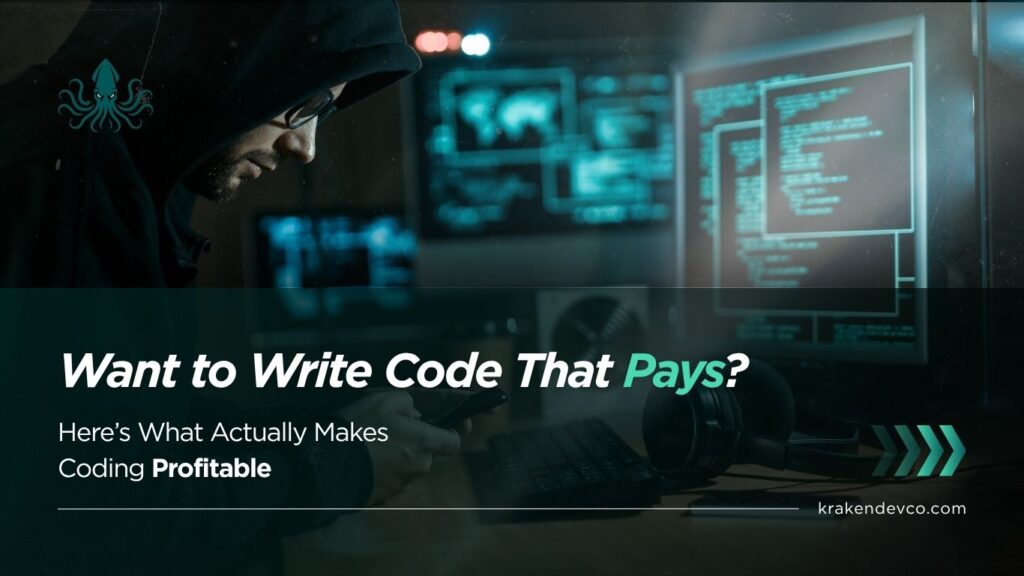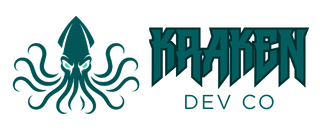
Want to Write Code That Pays? Here’s What Actually Makes Coding Profitable
Why do some developers earn six figures from a single app, while others spin their wheels chasing certifications and frameworks that never pay off?
The answer isn’t a secret language or magical stack. The most profitable coding isn’t about trends. It’s about solving real problems—with code that ships.
At Kraken Dev Co, we architect systems that generate results. That means everything we write is tested in market-facing deployments—not tutorials. If you’re serious about turning code into income, read on. We’re breaking down the principles, the projects, and the stacks that lead to profitable coding—no filler.
Code Doesn’t Pay. Shipping Does.
You don’t make money learning syntax. You make money building software that delivers value—then getting it in front of users, clients, or employers.
That’s why your focus shouldn’t be, “What language makes the most money?” Instead ask: “What problems are people paying to solve right now—and what’s the fastest way I can write software that does that?”
The Core Principle: Profitability Comes from Solving Problems with Code
Let’s say it plainly: profitable developers think like product builders. They look for:
- Repetitive tasks ripe for automation
- Data-heavy workflows that need better interfaces
- Offline processes begging for digitisation
- Industries stuck with legacy software and zero competition
These are code opportunities with margin. Whether you freelance, build SaaS, or ship internal tools at scale—profit comes from solving.
The Most Profitable Coding Languages (Based on Market Demand)
Here’s what the market values today—and where money flows:
1. JavaScript + TypeScript (Web)
- Primary use: Web apps, dashboards, eCommerce, SaaS
- Why it pays: Every business needs a frontend, and most want it fast. JavaScript powers 95% of the web.
- Profitable angle: Pair with React or Vue and deploy portfolio projects that mimic real SaaS.
2. Python (Data, AI, Automation)
- Primary use: AI/ML, backend APIs, scripting
- Why it pays: Python owns the automation and AI market. Easy to learn, powerful to scale.
- Profitable angle: Build AI-enhanced tools or automation bots that save people time or money.
3. Go (Backend + Scale)
- Primary use: High-performance APIs, microservices
- Why it pays: Used by startups and cloud platforms to serve millions of requests per second.
- Profitable angle: Build server-intensive tools, scale-heavy backends, or API-first platforms.
4. Solidity (Blockchain)
- Primary use: Smart contracts on Ethereum
- Why it pays: It’s where all the on-chain money is.
- Profitable angle: Build DApps, NFT platforms, DeFi tools—if you can ship secure code, you’ll get paid.
5. Swift/Kotlin (Mobile)
- Primary use: Native iOS and Android apps
- Why it pays: Mobile apps drive subscriptions and ad revenue.
- Profitable angle: Consumer-first tools, productivity apps, fintech wrappers.
These languages are monetisation vehicles. But the engine? That’s your project strategy.
5 Profitable Project Types That Translate to Revenue
1. Internal Tools for Businesses
- Examples: Inventory trackers, scheduling systems, client portals
- Tech: React + Firebase, Python + Flask, Supabase
- Why it pays: Every small business has admin headaches. Solve them with custom apps, and you’re on retainer.
2. SaaS Micro-Products
- Examples: Invoice generators, content planners, analytics dashboards
- Tech: MERN stack, Tailwind, Stripe integration
- Why it pays: Simple tools solving niche problems are subscription-ready.
3. Automation & Bots
- Examples: Email scrapers, lead gen tools, content curators
- Tech: Python, Selenium, Zapier, APIs
- Why it pays: Businesses pay to eliminate repetitive tasks. Automation is direct ROI.
4. APIs-as-a-Service
- Examples: Sentiment analysis, summarisation, address verification
- Tech: Go, Python, Node.js, Postgres
- Why it pays: Package your logic. Sell it to devs. Scale usage, not labour.
5. Blockchain Smart Contracts
- Examples: Token marketplaces, staking vaults, DAOs
- Tech: Solidity, Hardhat, React, Ethers.js
- Why it pays: Code that manages money attracts capital. But you must know security inside out.
Real-World Beginner Projects That Build Paid Skills
You don’t need to start with SaaS. Start where your skills are, but aim toward outcomes. Here’s a tiered roadmap:
Tier 1: Get the Fundamentals
- To-Do List – CRUD, state management
- Simple Calculator – Logic, UI
- Weather App – APIs, async fetch
- Password Generator – Input validation, copy to clipboard
- Quote of the Day App – JSON fetch, scheduling
Goal: Prove you can build functional tools. Publish to GitHub. Deploy on Vercel.
Tier 2: Client-Ready Apps
- Markdown Previewer – Real-time rendering
- Stock Tracker – Financial APIs, data visualisation
- Expense Tracker – Data storage, charting
- Chat App (WebSockets) – Real-time messaging
Goal: Build apps that solve a business task. Share case studies publicly.
Tier 3: Product-Grade Builds
- Airbnb Clone (MERN) – Full-stack data flow
- Real-time Collaboration (WebRTC) – Advanced browser APIs
- AI-Powered Note Sorter – Integrate OpenAI or vector search
- Donation Platform – Payments, authentication, data handling
Goal: Launch a monetisable MVP. Sell access or grow a user base.
Build Public, Ship Fast, Iterate
Your code only becomes profitable when people can see it, use it, and pay for it. Here’s your deployment plan:
- Version 0.1 MVP: Get it working. Ugly is fine.
- GitHub with README: Explain tech stack, functionality, next steps.
- Deploy Free: Use Netlify/Vercel/Firebase.
- Write About It: Share learnings on LinkedIn or Dev.to.
- Make it Sharable: Add demo video, open a feedback channel.
- Iterate Based on Use: Add features, fix edge cases, improve UX.
If it works once, repeat. Profitable developers don’t build once—they build engines.
Bonus: How to Create Your Own Profitable Project Ideas
The most profitable apps are ones you can’t find… because they don’t exist yet. Here’s how to create them:
- Start with friction: What’s something you or your team repeatedly waste time on?
- Observe tools you use: Is there a clunky Excel file? A bad UI? Build a better version.
- Ask businesses: What’s your biggest operational bottleneck? Build the solution.
- Scratch your own itch: Code a tool you’d pay for yourself.
A real example: One dev wanted to practise Spanish. Phone calls were awkward. They built a browser-based language partner using speech recognition. Now it’s a real product.
Monetisation Routes for Coders
Once your builds are out, here’s how to turn them into revenue:
- Freelance: Use your projects to pitch clients and land gigs.
- SaaS: Turn a build into a monthly subscription product.
- APIs: Charge per request or by tiered access.
- Affiliate: Monetise tools with referral links or product integrations.
- Job-ready: Projects are more convincing than CVs—use them to break into high-paying dev roles.
Final Thought: What Makes Coding Profitable?
It’s not the language. It’s not the framework. It’s how quickly you can take an idea and turn it into something functional that other people value.
The most profitable coding is code that ships, solves, and scales. That’s what we do at Kraken Dev Co—and that’s what you should do too.
Need help turning code into revenue?
At Kraken Dev Co, we build systems that scale and infrastructure that earns. From AI deployment to full-stack SaaS architecture—we don’t talk about building. We build.
Let’s build something profitable →



